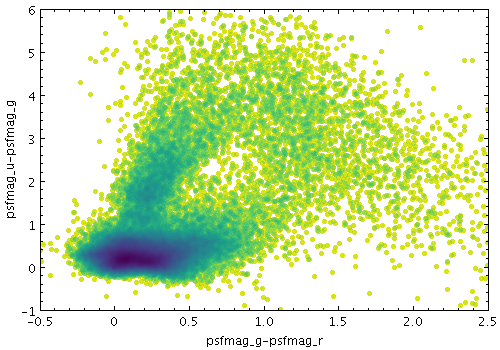
density
Paints markers using a configurable colour map to indicate how many points are plotted over each other. Specifically, it colours each pixel according to how many times that pixel has has been covered by one of the markers plotted by the layer in question. To put it another way, it generates a false-colour density map with pixel granularity using a smoothing kernel of the form of the markers plotted by the layer. The upshot is that you can see the plot density of points or other markers plotted.
This is like auto mode, but with more user-configurable options.
Usage:
shadingN=density colorN=<rrggbb>|red|blue|...
densemapN=<map-name>|<color>-<color>[-<color>...]
denseclipN=<lo>,<hi> denseflipN=true|false
densequantN=<number> densesubN=<lo>,<hi>
densefuncN=log|linear|histogram|...
All the parameters listed here
affect only the relevant layer,
identified by the suffix
N.
Example:

stilts plot2plane layer1=mark in1=dr5qso.fits
x1=psfmag_g-psfmag_r y1=psfmag_u-psfmag_g size1=2
shading1=density densemap1=viridis
xmin=-0.5 xmax=2.5 ymin=-1 ymax=6
Associated parameters are as follows:
colorN = <rrggbb>|red|blue|... (Color)
The standard plotting colour names are
red, blue, green, grey, magenta, cyan, orange, pink, yellow, black, light_grey, white.
However, many other common colour names (too many to list here)
are also understood.
The list currently contains those colour names understood
by most web browsers,
from AliceBlue to YellowGreen,
listed e.g. in the
Extended color keywords section of
the CSS3 standard.
Alternatively, a six-digit hexadecimal number RRGGBB
may be supplied,
optionally prefixed by "#" or "0x",
giving red, green and blue intensities,
e.g. "ff00ff", "#ff00ff"
or "0xff00ff" for magenta.
[Default: red]
denseclipN = <lo>,<hi> (Subrange)
If the full range 0,1 is used,
the whole range of colours specified by the selected
shader will be used.
But if for instance a value of 0,0.5 is given,
only those colours at the left hand end of the ramp
will be seen.
If the null (default) value is chosen,
a default clip will be used.
This generally covers most or all of the range 0-1
but for colour maps which fade to white,
a small proportion of the lower end may be excluded,
to ensure that all the colours are visually distinguishable
from a white background.
This default is usually a good idea if the colour map
is being used with something like a scatter plot,
where markers are plotted against a white background.
However, for something like a density map when the whole
plotting area is tiled with colours from the map,
it may be better to supply the whole range
0,1 explicitly.
denseflipN = true|false (Boolean)
[Default: false]
densefuncN = log|linear|histogram|... (Scaling)
The available options are:
log: Logarithmic scaling, positive values onlylinear: Linear scalinghistogram: Scaling follows data distribution, with linear axishistolog: Scaling follows data distribution, with logarithmic axis, positive values onlyasinh: Asinh scaling, wide dynamic range for both positive and negative valuessqrt: Square root scalingsquare: Square scalingacos: Inverse cosine Scalingcos: Cosine ScalingFor all these options,
the full range of valid data values is used,
and displayed on the colour bar
if applicable (though it can be restricted using the densesub option)
Note that logarithmic-based options
Log and
HistoLog
will ignore non-positive values.
The Linear,
Log,
Square and
Sqrt options
just apply the named function to the full data range.
The histogram options on the other hand use a scaling function
that corresponds to the actual distribution of the data, so that
there are about the same number of points (or pixels, or whatever
is being scaled) of each colour.
The histogram options are somewhat more expensive,
but can be a good choice if you are exploring data whose
distribution is unknown or not well-behaved over
its min-max range.
The Histogram and
HistoLog options both
assign the colours in the same way, but they display the colour
ramp with linear or logarithmic annotation respectively;
the HistoLog option also ignores
non-positive values.
[Default: log]
densemapN = <map-name>|<color>-<color>[-<color>...] (Shader)
A mixed bag of colour ramps are available
as listed in Section 8.7:
blacker,
whiter,
inferno,
magma,
plasma,
viridis,
cividis,
cubehelix,
sron,
rainbow,
rainbow2,
rainbow3,
pastel,
cosmic,
ember,
gothic,
rainforest,
voltage,
bubblegum,
gem,
chroma,
sunset,
neon,
tropical,
accent,
gnuplot,
gnuplot2,
specxby,
set1,
paired,
hotcold,
guppy,
iceburn,
redshift,
pride,
rdbu,
piyg,
brbg,
cyan-magenta,
red-blue,
brg,
heat,
cold,
light,
greyscale,
colour,
standard,
bugn,
bupu,
orrd,
pubu,
purd,
painbow,
huecl,
infinity,
hue,
intensity,
rgb_red,
rgb_green,
rgb_blue,
hsv_h,
hsv_s,
hsv_v,
yuv_y,
yuv_u,
yuv_v,
scale_hsv_s,
scale_hsv_v,
scale_yuv_y.
Note:
many of these, including rainbow-like ones,
are frowned upon by the visualisation community.
You can also construct your own custom colour map
by giving a sequence of colour names separated by
minus sign ("-") characters.
In this case the ramp is a linear interpolation
between each pair of colours named,
using the same syntax as when specifying
a colour value.
So for instance
"yellow-hotpink-#0000ff"
would shade from yellow via hot pink to blue.
[Default: blacker]
densequantN = <number> (Double)
If left blank, the colour map is nominally continuous (though in practice it may be quantised to a medium-sized number like 256).
densesubN = <lo>,<hi> (Subrange)
The default value "0,1" therefore has
no effect.
The range could be restricted to its lower half
with the value 0,0.5.
[Default: 0,1]